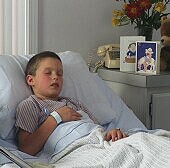
TUESDAY, Jan. 31 (HealthDay News) — When children are sick, family participation is central to their treatment, says a new policy statement from the American Academy of Pediatrics, which calls for patients, their parents and pediatricians to become partners at every level of care.
In the hospital, parents should be encouraged to stay with their child, sit in on physician “rounds,” and accompany the youngster during medical procedures, the statement says. Pediatricians should also offer parents support, respect their preferences about care and communicate openly with children and teenagers about their condition.
“It’s incorporating where the family stands, its belief systems, to help in making decisions,” said Dr. Jerrold Eichner, co-author of the statement and a pediatric pulmonologist and past chair of the AAP’s Committee on Hospital Care. “It’s a gradual movement, going on for decades.”
The statement, published online Jan. 30 and in the February print issue of Pediatrics, was met with praise from a family health advocate.
“I’m actually very appreciative of the statement,” said Karen Herzog, co-founder of Sophia’s Garden Foundation, an organization centered on helping families with children with life-threatening conditions.
“It’s imperative that professional organizations like the AAP and the American Medical Association take a firm stand on patient- and family-centered care,” she said. “We need to work in partnership to improve our health outcomes together.
Herzog’s daughter died of a rare illness when she was 4 years old. Her family took ownership of her care to an uncommon degree.
“I actually recruited practitioners to work on her care team, both local and internationally. We wanted to assemble a team that incorporated many different disciplines and cultural values and different medical perspectives,” Herzog said.
One priority was making sure that care was about Sophia’s needs rather than fitting into standard practice.
“We were with hospice for two and a half years,” Herzog said. “Usually they just stay when a child has six months or fewer to live. At that time, we chose to have curative care [as well]. We wanted to be able to take our child to the doctor or hospital at any point in time that we chose, rather than when it was approved by hospice.”
AAP’s new policy supports this kind of flexibility.
It encourages “honoring patient and family experiences and incorporating them with patient and family preferences into the planning and delivery of health care,” and tailoring services to “family-patient needs, beliefs, cultural values.”
Cultural sensitivity is important, Eichner said. “If a patient or family has a cultural or personal aversion, they may not tell you; they just won’t comply with the treatment,” he said.
The statement lays out specifics for family inclusion. “In hospitals, conducting attending physician rounds [patient presentation and discussions] in the patients’ rooms with nursing staff and the family present should be standard practice,” it said, and parents should have the option to be present during medical procedures.
Herzog said she wished the policy placed more emphasis on pediatric care in the home, and on families of children with special needs.
Also missing is a strong recognition of health information technology, Herzog said. “The policy talks about the flow of information. [But] there’s nothing about electronic medical records,” she explained.
She also wants “openness to practitioners when patients bring in information that they’ve found on the Internet.”
The statement does address peer-to-peer communication, and social media and the Internet is part of that, Eichner said. For his patients with cystic fibrosis, diabetes and other chronic conditions, “[the web] is especially helpful for older kids.”
Collaboration includes involving patients and families in task forces, advisory councils and committees to improve patient safety, and as leaders of peer-support programs, the statement said.
Getting patients and families onboard helps doctors as well, Eichner said. “It’s a lot easier to deal with patients when they feel you’re listening,” he added. “When they know that you’ll be honest with them and give them the complete story on what’s going on with their child.”
A “sea change” is happening in health care, Herzog said.
One sign is “coming out with a stance like this, something that pediatricians can adhere to, when they’re rated by their peers,” she said. “They can be evaluated by AAP or other organizations. If there’s any kind of problem, did the physicians adhere to these standards? They’re like minimally acceptable standards.”
More information
Visit the Institute for Patient- and Family-Centered Care to learn more about the concept and practice.

